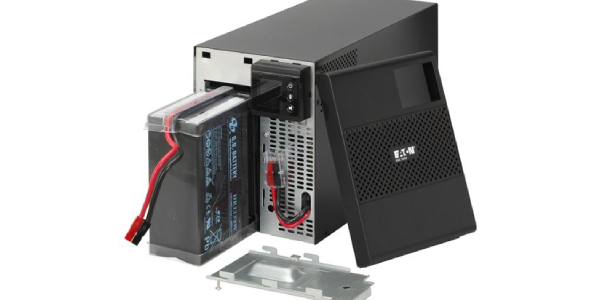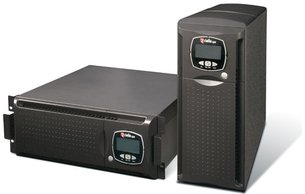 Introduction
Introduction
The battery system in a UPS forms the heart of the power protection benefit to the user. It is a key element which performs two functions:
1) delivers energy during a power outage
2) stores energy efficiently for extended periods of time. That stored energy is instantaneously available when needed to support the critical load on the UPS. In order to perform the above functions reliably, the charge level on the battery must be maintained. At the same time, it is desired that the battery charge be controlled to maximize system efficiency and, more importantly, to maximize the service life of the battery system. The unfortunate fact is that Valve Regulated Lead Acid (VRLA) batteries are often marketed as “10 year design life”, yet real world data shows that in UPS applications, the battery is replaced every 4-5 years on average. Because the battery can often be 30% of the cost of the UPS system, users frequently request that the UPS vendor ensure that the service life of the battery be extended as much as possible. They require tangible evidence that “battery monitoring” and “battery management” systems actually perform as advertised. The benefit of longer service life is lower life cycle cost and capital expense for the user.
Two types of battery charging schemes have traditionally been used for UPS battery systems. The older and more commonly known is the “float” charge scheme. This involves applying a constant voltage charge to the battery continuously for purposes of maintaining full charge during day-to-day operation of the UPS. This works quite well in many conventional battery applications. However, it can result in reduced battery life, due to overcharging, for batteries that are used very occasionally as in standby applications like UPS. In a UPS, the battery system may sit in float mode for many months, without ever experiencing a discharge. Float charging for long periods of time means that “trickle charge” energy is constantly forced into a battery which is effectively “already full”. This results in very gradual degradation of the lead plates (positive grid corrosion), and significantly reduces service life. Standby applications are better suited for “cyclic” charging schemes. The system Eaton utilizes is called Advanced Battery Management (ABM) charging system. ABM is a set of charger controls, and automated battery tests. It is implemented in Eaton 3 phase UPS systems from 10 kVA to 3.3 MVA. Cyclic charging schemes like ABM allow for periods of time where the battery is being fully charged, and periods of time when the charger is disabled. This reduces the time that the battery is being overcharged when compared to a traditional float charger. This reduction in overcharging yields a measurable increase in battery life for UPS applications.
Charge Mode
The UPS enters Charge mode under any of the following conditions:
Whenever the UPS is commanded to turn on
After any Utility power outage, lasting longer than 15 seconds
Whenever the battery is replaced (or the battery breaker is opened and re-closed)
In Charge mode, bulk charging of the batteries is used to recharge a discharged battery after a power outage, or whenever the ABM process is restarted. Charge voltage target is set to 2.30 V/cell, and charge current will be greater than 0.1 C A. Bulk charging lasts only as long as it takes to bring the battery system up to a predetermined float level (there is a 100-hour maximum time limit). Once this level is reached, the UPS battery charger enters a constant voltage mode, maintaining a 2.3 V/cell level. Current is at trickle charge levels during this time, and a 24-hour clock is started. At the end of 24 hours of float charging, the UPS automatically performs a battery test (see fig. 1) at two different load levels to verify that the battery is performing, and to collect data for comparison to previous and subsequent automatic battery tests. If the test should fail, an alarm is annunciated on the UPS and also through the remote monitoring system that may be connected to the UPS. At the end of the test, the charger resumes constant voltage mode, and remains in that state for an additional 24 hours.
 Rest Mode
Rest Mode
Rest mode begins at the end of Charge mode; that is, after 48 hours of float charging, and after a successful battery test. In Rest mode, the battery charger is completely turned off. The battery system receives no charge current during this mode, which lasts about 28 days. Then, the Charge mode is repeated as described above. It is clear, then, that the battery spends most of its time in Rest mode. As a result, the following benefits are realized:
Battery is not subjected to forced charge current; therefore, overcharging is not possible.
Thermal runaway is not a concern with the charger off.
The battery system can not be damaged by ripple currents,since the charger is off.
The likelihood of positive grid corrosion is greatly reduced, allowing extended service life.
During Rest mode, the open circuit battery voltage is monitored constantly, and battery charging is resumed if any of the following occur:
A power outage lasting longer than 15 seconds occurs
The OCV (open circuit voltage) of the battery drops below 2.1 V/cell after 10 days of rest mode
If OCV drops below 2.1V during the first 10 days, an alarm is triggered
28-day timer expires (end of Rest Mode)
The battery is replaced, or the breaker is opened and re-closed
There are two other battery tests that are performed as a part of the ABM cycle. The first of these is meant to detect battery conditions which could lead to thermal runaway. The bulk charging period is timed and if the float voltage is not reached in a predetermined time an alarm is signaled, and the charger shut down. The second test is performed after the charge cycle is completed (i.e., at the beginning of Rest mode). The battery is discharged for 25% of the expected discharge time. Upon reaching this point the battery voltage is measured. If the voltage is below a specified threshold, dependent on the load, then an alarm is signaled indicating the battery is nearing the end of its service life and should be replaced.
Other Modes
Disabled mode: note that ABM may be disabled by the user or an Eaton field service engineer at any time, if desired. In this case, the UPS battery charger operates as a conventional float charger only. This is recommended when a wet cell or flooded electrolyte battery is used with the UPS. ABM is intended for use with VRLA batteries, wet batteries will not benefit from ABM controls. Many observers express concern regarding the remaining capacity of the battery if called upon to support the UPS near the end of its Rest mode. In other words, how much battery capacity is available on day 27 of a 28-day rest mode? In general, and using a 15 minute battery as an example, under this condition, the battery would provide all but about 30 seconds of its 15 minute backup time. This is proportionally true for other battery sizes.
ABM Performance
The ABM process above describes benefits of using a “cyclic” charging scheme. Those benefits, specifically extended service life, are in fact substantiated by data and empirical testing performed by Eaton, and also by other independent sources. Some of this testing is recent, and some was performed as much as 20 years ago. Eaton has 18 years of experience using ABM in its UPS products. It is not a “new battery management” feature. It has proven itself beneficial in the field for almost two decades.
Read More: Single Phase UPS
Leave a Reply